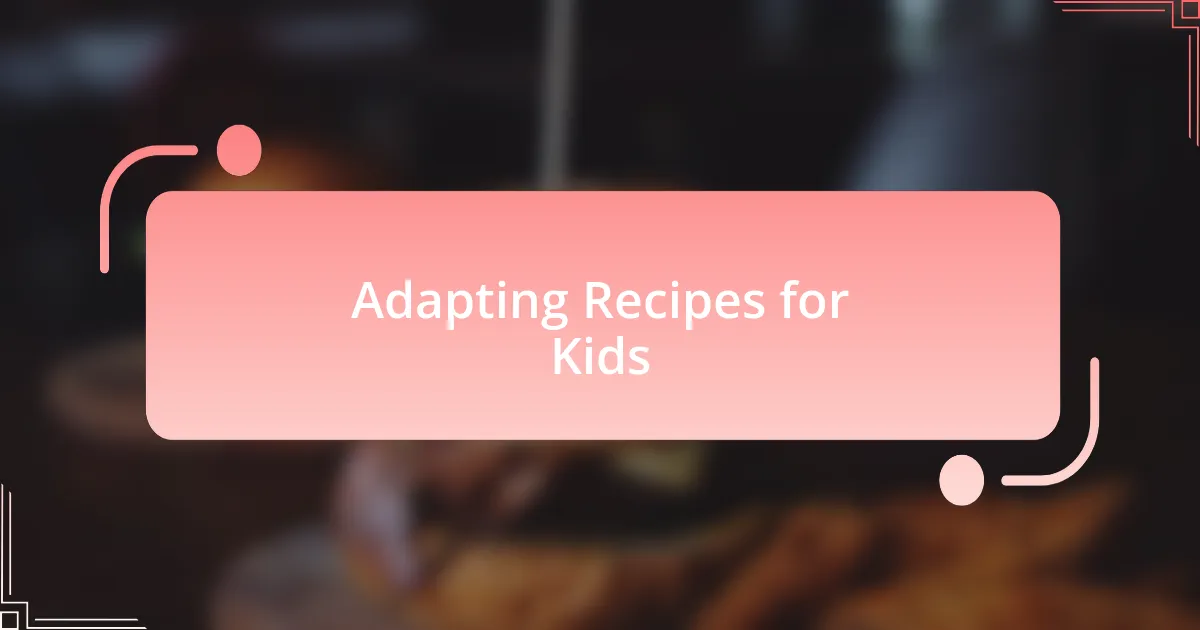Key takeaways:
- Healthy eating involves choosing whole foods, fostering mindfulness, and enjoying cooking together, creating lasting family bonds and experiences.
- Regular family meals encourage healthier eating habits, deeper conversations, and stability in a fast-paced lifestyle.
- Incorporating variety and making meals visually appealing can stimulate children’s interest in trying new foods, enhancing their relationship with healthy eating.
- Meal prep simplifies weeknight cooking and fosters independence in children, making them more enthusiastic about meal choices.

Understanding Healthy Eating
Healthy eating is more than just choosing fruits and vegetables; it’s about understanding how those choices nourish our bodies and impact our well-being. I remember a time when I struggled to find balance in my family’s diet. It was overwhelming to navigate nutrition labels and contradictory advice. But once I began focusing on whole foods and mindful eating, I noticed a significant change—not just in my energy levels but also in my family’s relationship with food.
I often reflect on how we intuitively know what makes us feel good. Have you ever noticed the difference in mood after enjoying a wholesome meal versus processed snacks? That feeling of satisfaction that comes from a colorful plate brimming with diverse nutrients is something I cherish. It’s a reminder of the connection between what we eat and how we feel, which is foundational in understanding healthy eating.
Moreover, embracing healthy eating doesn’t have to be restrictive. It’s about finding joy in cooking and savoring meals together. I’ve had evenings where experimenting with new recipes turned into laughter-filled family events. Those moments reinforce my belief that healthy eating is a journey, not a destination—one that brings us together and enriches our lives in countless ways.

Importance of Family Meals
Family meals hold a special place in our daily routines. I still remember Sunday dinners at my grandmother’s house, where we gathered around the table not just to eat, but to connect. Those moments strengthened our family bonds and created lasting memories. Have you ever felt how sharing a meal can lead to deeper conversations? It’s in those shared experiences that understanding and empathy flourish.
Research supports what many of us instinctively feel: regular family meals can lead to healthier eating habits and improved well-being. I’ve noticed that when we sit down together, my kids are more likely to try new vegetables or even ask for seconds. It’s fascinating how family meals can encourage adventurous eating, turning taste testing into fun rather than a chore.
Additionally, the rhythm of family meals offers stability in a fast-paced world. I often find that during our dinner time, we put aside our devices and focus on each other. This dedicated time allows for reflection and sharing about our day—what went well and what didn’t. Isn’t it incredible how a simple meal can nurture communication and foster relationships?

Planning Balanced Meals
Planning balanced meals is essential for nurturing our family’s health and well-being. I often sit down with a pen and paper to jot down what each family member enjoys while ensuring nutritional variety. The way I see it, creating a meal plan is like crafting a puzzle where each piece contributes to a wholesome picture. Have you ever felt that thrill of finding just the right ingredients to please everyone?
Considering food groups is a key part of my meal planning process. I like to include a protein source, whole grains, and plenty of colorful vegetables in every meal. For instance, a typical Tuesday dinner might be grilled chicken, quinoa, and steamed broccoli. You’d be surprised how quickly my kids warm up to vegetables when they’re vibrant and paired with delicious flavors. Have you noticed how a bit of creativity can shift the meal dynamic entirely?
Sometimes, I find that hosting a theme night brings excitement to our meal planning. Perhaps it’s “Taco Tuesday” or “Pasta Night,” where everyone can personalize their plate. These themed dinners spark joy and encourage my kids to explore different tastes and textures while learning about food diversity. When was the last time you got your family involved in planning a meal? It’s a fantastic way to teach them about balanced nutrition while having fun.

Incorporating Variety in Diet
Incorporating variety into our family meals is not just about nutrition; it’s an adventure. I remember one night, inspired by the colors of a farmer’s market, I created a vibrant grain bowl filled with roasted sweet potatoes, black beans, and a sprinkle of feta. My kids were initially skeptical, but upon tasting it, their expressions shifted from hesitation to delight. Have you ever watched a child discover a newfound love for a particular food? It’s pure magic!
I often encourage my family to try one new ingredient each week. This week, for instance, I introduced farro to our dinner table. It was fascinating to see my youngest experimenting with it, mixing it into her salad and daring to add a splash of tahini dressing. This simple practice keeps meals exciting and opens the door to constant conversations about flavor profiles and textures. Can something as small as a new ingredient ignite a passion for cooking in your little ones?
Another effective strategy I apply is balancing familiar favorites with new dishes. On the nights when I present a new recipe, I always include a trusted go-to, like homemade pizza or tacos, to provide comfort. This method not only reassures my kids but serves as a gateway to exploring different culinary cultures. Have you noticed how blending the new with the familiar can make food feel less intimidating? It’s a wonderful way to cultivate a love for healthy eating while keeping dinner enjoyable for everyone.

Cooking Techniques for Families
Cooking techniques are pivotal in making family meals not only nutritious but also fun and engaging. One technique that has worked wonders for me is batch cooking. I recall a Sunday afternoon when I prepared a big pot of vegetarian chili. By the end of the day, not only did I have several ready-to-go meals for busy weeknights, but I also turned the kitchen into a bustling hub where my kids helped chop vegetables and mix spices. Have you ever noticed how cooking together can spark genuine excitement about food?
Another approach I find particularly useful is the art of one-pan meals. These simplify the cooking process and keep cleanup at a minimum, which is a huge relief after a long day. I remember showcasing a one-pan roasted salmon with seasonal veggies to my family last week. They loved how the flavors melded together while appreciating the colorful presentation. Don’t you find that the less mess you have, the more time you have to enjoy each other’s company around the table?
Lastly, I advocate for teaching kids basic cooking skills. Simple tasks, like washing vegetables or stirring sauces, can empower them and invest them in the meal preparation. The other day, my youngest asked if she could try her hand at making scrambled eggs. Watching her crack the eggs and whisk them with enthusiasm brought me immense joy. Isn’t it heartwarming to witness children take ownership of their food? This not only builds confidence but also fosters a lasting interest in healthy cooking habits.

Tips for Meal Prep
Meal prep is all about making life easier, especially during hectic weekdays. I’ve found that dedicating just a couple of hours each weekend to chop vegetables and marinate proteins can make a significant difference. One Saturday, I prepped all the ingredients for a stir-fry dish, and when it was dinner time, it felt like magic—everything was ready within minutes. Have you ever experienced that relief when dinner comes together effortlessly?
Another tip I’ve employed is to use clear, labeled containers for storage. This not only keeps my fridge organized but also allows my kids to pick their meals independently. I recall one evening when my daughter excitedly helped herself to a pre-portioned quinoa salad. The look on her face as she discovered her meal made me realize how empowering it is for her to make choices. Don’t you think that fostering independence in meal selection encourages kids to try new foods?
Lastly, I always plan my meals around what my family enjoys. By involving my kids in the meal-planning process, I’ve noticed they’re more enthusiastic about eating what we prepare together. Just the other day, we sat down to brainstorm ideas, and my son suggested tacos. I was surprised and delighted! By making meal prep a collaborative effort, we create excitement and anticipation for the week ahead. Isn’t it wonderful how a little teamwork can bring everyone to the table with smiles?

Adapting Recipes for Kids
Adapting recipes for kids is often a balancing act between health and taste. When I try to introduce new ingredients, like kale or chickpeas, I make sure to blend them into familiar favorites. For example, I once added leafy greens into a classic pasta dish, and to my surprise, my kids loved it when I called it “super veggie pasta.” Isn’t it fascinating how a playful name can change their perception of food?
To make meals visually appealing, I often involve my little ones in the preparation. The other day, my daughter helped me assemble colorful veggie skewers, and she was so proud to present her creation at dinner. It was heartwarming to see her enthusiasm—she actually ate more vegetables that night than ever before. Isn’t it uplifting to witness kids embracing healthy options when they feel part of the process?
Another approach I take is to tweak flavors to align with my kids’ tastes. For instance, I’ve found that adding a hint of sweetness, like a drizzle of honey or a sprinkle of cinnamon, can encourage them to try dishes they might initially resist. Just last week, I made a butternut squash soup and sweetened it just enough to appeal to their palates. Have you ever noticed how a simple adjustment can transform a meal into a family favorite?